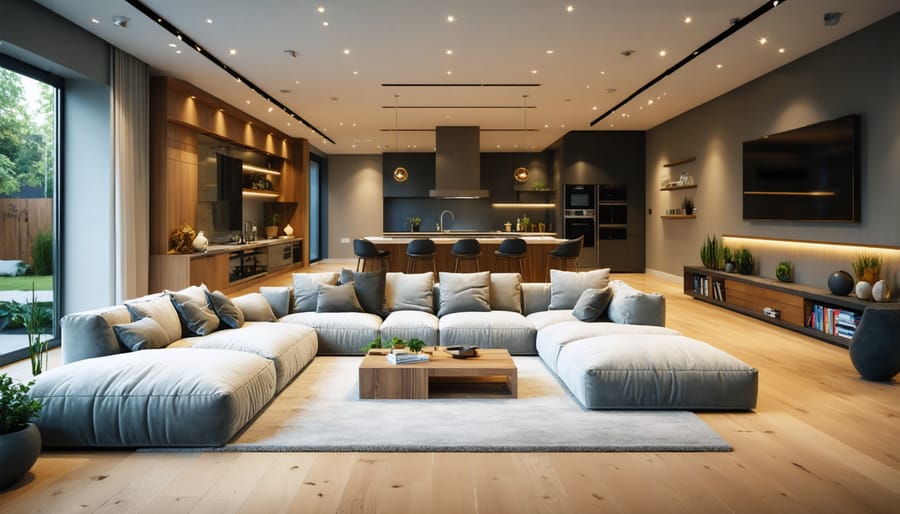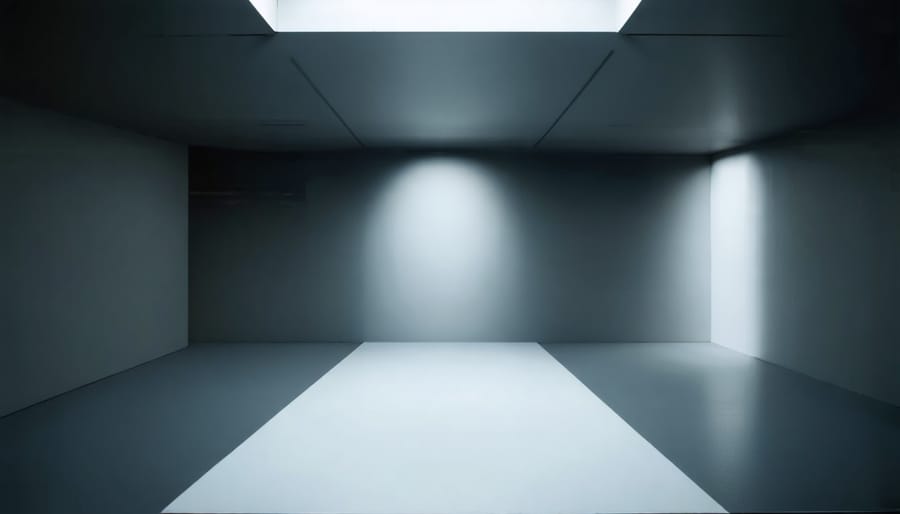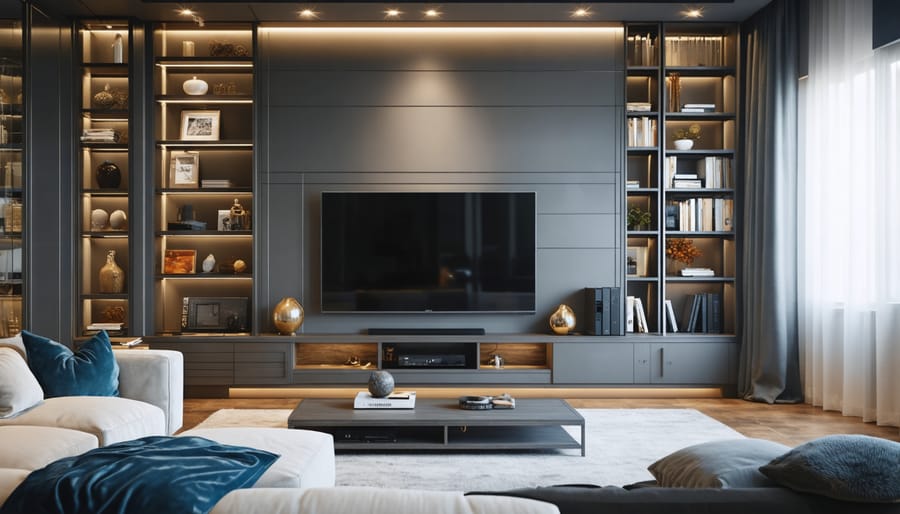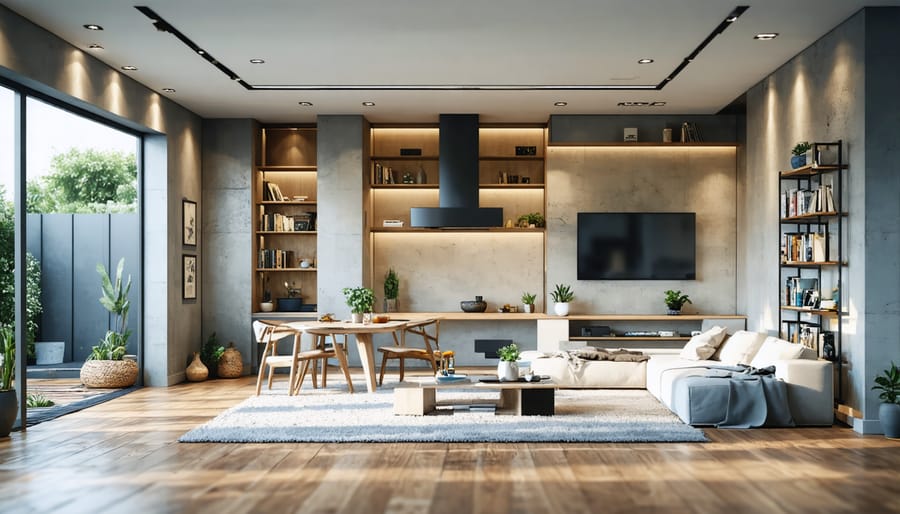Transform an underutilized basement into a versatile living space by removing non-load-bearing walls, maximizing natural light with enlarged window wells, and creating distinct functional zones without physical barriers. Open concept basements revolutionize home living, offering unlimited potential to transform your dark basement into a vibrant multi-purpose area that seamlessly flows from one activity zone to another. Strategic furniture placement, thoughtful lighting design, and creative storage solutions define spaces while maintaining an airy, expansive feel. Elevated flooring transitions and varied ceiling treatments subtly delineate areas without compromising the open layout, while consistent design elements throughout unite the space. Modern basement renovations embrace this fluid approach, replacing traditional compartmentalized rooms with flexible spaces that adapt to changing family needs – from home offices and entertainment zones to workout areas and guest accommodations – all while maintaining visual continuity and maximizing square footage.
Planning Your Open Concept Basement Layout
Structural Considerations
Before diving into your open concept basement dreams, it’s crucial to understand the structural elements at play. Load-bearing walls are the backbone of your home, supporting the weight of the floors above. While some walls can be removed to create that coveted open feel, load-bearing walls require special attention and professional assessment.
Don’t worry if you spot support columns in your basement – these vertical posts are essential structural elements that can be creatively incorporated into your design. Consider wrapping them in attractive materials or turning them into feature elements, like part of a breakfast bar or built-in shelving unit.
When planning your open concept layout, you’ll need to work with a structural engineer to evaluate your space. They’ll determine which walls can be safely removed and where additional support might be needed. Sometimes, steel beams can replace load-bearing walls to maintain structural integrity while opening up the space.
Remember that local building codes will dictate certain requirements for ceiling height, emergency exits, and structural modifications. Always obtain necessary permits before starting any structural work. While these considerations might seem limiting, they’re actually opportunities to get creative with your design while ensuring your basement remains safe and sturdy for years to come.
Consulting professionals early in your planning process can save you time, money, and potential headaches down the road.
Space Zoning Strategies
Creating distinct zones in an open-concept basement doesn’t require physical walls. Instead, use clever design techniques to define different areas while maintaining the spacious feel. Start by mapping out your desired functions – perhaps you want to design the perfect workspace alongside a cozy entertainment area.
Area rugs are your best friends in zone definition. Use large rugs to anchor different spaces, such as placing one under your seating area and another in your gaming zone. Strategic furniture placement also plays a crucial role – position your sofa with its back to other zones to create a natural barrier, or use open bookcases as room dividers that maintain sight lines while establishing boundaries.
Lighting is another powerful zoning tool. Install different lighting schemes for each area: pendant lights over a bar area, recessed lighting for the TV zone, and task lighting for workspaces. Consider using varying ceiling treatments, like suspended panels or exposed beams, to subtly mark different zones.
Level changes, even slight ones using platforms, can effectively separate areas while adding visual interest. For flexible zoning, incorporate mobile elements like rolling storage units or modular furniture that can be easily rearranged when needed. Remember to maintain a consistent color palette throughout to ensure the spaces feel connected despite their distinct functions.

Design Elements That Define Spaces
Lighting Solutions
Lighting can make or break your open concept basement, and with the right strategy, you can create distinct zones while maintaining a cohesive feel. Start with ambient lighting through recessed can lights spaced evenly across the ceiling – this provides essential overall illumination without taking up valuable headspace.
Layer your lighting by incorporating task lighting in specific areas. Install pendant lights over a game table or bar area, under-cabinet lighting in the kitchenette, and adjustable track lighting to highlight artwork or architectural features. These focused light sources help define different functional spaces without physical barriers.
Consider natural light sources too. If you have egress windows, maximize their impact by keeping window wells clean and using light-colored window treatments. For areas far from natural light, try tubular skylights or solar tubes to bring sunshine into darker corners.
Create ambiance with accent lighting. LED strip lights under floating shelves or along baseboards add a modern touch while providing subtle illumination. Wall sconces can create intimate seating areas, while floor lamps offer flexibility for reading nooks or workout spaces.
Smart lighting solutions are worth considering – install dimmable fixtures and programmable LED systems to adjust the atmosphere throughout the day. Group your lights by zone and create preset scenes for different activities, from movie watching to entertaining.
Pro tip: Always install more light fixtures than you think you’ll need, but put them on separate switches. This gives you maximum control over the ambiance and allows you to adjust lighting levels based on the time of day or activity.

Flooring Transitions
In an open concept basement, flooring transitions play a crucial role in defining different functional areas without using physical walls. By strategically mixing flooring materials, you can create visual boundaries that maintain the spacious feel while clearly designating specific zones.
Consider using luxury vinyl planks in your main living area for their durability and water-resistant properties, then transition to cozy carpeting in the entertainment or family room space. This simple change in texture and material naturally guides the eye and helps establish distinct areas within the open layout.
For your home gym area, rubber flooring or interlocking foam tiles provide essential cushioning and sound dampening, while being easy to install and maintain. When transitioning between different flooring types, use metal or wooden transition strips to create clean, professional-looking seams that prevent tripping hazards.
In wet areas like the bar or bathroom space, opt for waterproof materials like ceramic tiles or sealed concrete. You can create interesting patterns or use different tile sizes to subtly mark these zones without disrupting the overall flow of your basement.
Pro tip: Keep the color palette cohesive across different flooring materials to maintain visual harmony. For example, if you’re using warm-toned wood-look vinyl in one area, choose carpeting or tiles in complementary warm shades for other spaces.
Remember to consider the height differences between various flooring materials during planning. This ensures smooth transitions and prevents awkward elevation changes that could affect furniture placement or create safety concerns.
Smart Storage Solutions
Built-in Options
One of the most elegant ways to maintain an open concept basement while maximizing storage is through built-in solutions that seamlessly integrate with your space. Consider floor-to-ceiling shelving units that can be painted to match your walls, creating a cohesive look while providing ample storage space. Built-in window seats with hidden compartments offer both charm and functionality, perfect for stowing away seasonal items or extra blankets.
Transform those awkward spaces under stairs into clever storage solutions by installing custom drawers or pull-out cabinets. These areas are ideal for storing rarely-used items while maintaining the clean lines of your open layout. Consider incorporating media centers with hidden storage compartments that blend naturally with your walls, keeping entertainment equipment and media collections organized yet out of sight.
Wall-mounted cabinets in strategic locations can provide storage without breaking up the visual flow of your space. Choose floating designs that leave floor space visible underneath, creating an illusion of more room while offering practical storage options. Remember to include adequate lighting within or around these built-ins to prevent dark corners and showcase your organizational systems effectively.

Multifunctional Furniture
In an open concept basement, every piece of furniture should work twice as hard to maximize your space. Consider ottomans with hidden storage compartments – perfect for stashing away blankets and board games while serving as extra seating during family gatherings. Modular sofas are another smart choice, allowing you to reconfigure your seating arrangement based on different activities, from movie nights to hosting guests.
Look for expandable dining tables that can be compact for daily use but extend when you’re entertaining. Coffee tables with lift-tops serve as impromptu work surfaces or dining spots while concealing storage underneath. Wall-mounted desks that fold down when needed and disappear when not in use are excellent space-savers for home office corners.
Don’t overlook the versatility of storage benches along walls – they provide seating while organizing toys, sports equipment, or seasonal items. Consider investing in nesting tables that can be tucked away or spread out as needed, and room dividers with built-in shelving that create distinct zones while displaying books and decorative items.
For entertainment areas, media consoles with adjustable components allow you to hide electronics and cables while providing display space for decor. Murphy beds or sleeper sofas can transform a general-purpose space into a guest room when needed, making your basement truly multifunctional.
Popular Open Concept Layouts
Entertainment-Focused Designs
Transform your basement into the ultimate entertainment hub with strategic layouts that maximize both fun and functionality. Start by establishing a primary focal point, typically a large-screen TV or projector setup, positioned to minimize glare and provide optimal viewing angles for everyone in the room.
Create distinct zones within the open space: a cozy viewing area with plush seating, a gaming corner with storage for consoles and controllers, and a casual dining or bar area for snacks and refreshments. Consider incorporating a mini kitchen or wet bar to minimize trips upstairs during movie marathons or game nights.
Flexible seating arrangements are key – mix fixed seating like built-in benches with movable pieces like ottomans and sectionals. This allows you to easily reconfigure the space for different activities, from intimate movie nights to larger gatherings.
Don’t forget about acoustics! Use area rugs, upholstered furniture, and sound-absorbing panels to manage noise levels while maintaining the open feel. Strategic lighting is crucial too – install dimmable fixtures and task lighting to create the perfect ambiance for any activity.
For extra functionality, consider adding a game table area for activities like pool, ping pong, or board games. Keep the space feeling cohesive by using consistent design elements and color schemes throughout, while ensuring clear pathways between activity zones.
Remember to include plenty of storage solutions for entertainment equipment, games, and media, keeping the open concept clutter-free and inviting.
Work-Play Combinations
Gone are the days when basements were solely for recreation or work – today’s open concept designs expertly blend both worlds. Creating a harmonious work-play combination allows you to maximize your basement’s potential while maintaining a spacious feel. The key is establishing distinct zones without physical barriers.
Consider dedicating one area to a productive home office space using area rugs, strategic lighting, and furniture placement to define boundaries. Position your desk to face away from entertainment areas to minimize distractions while working. A sleek room divider or decorative screen can provide visual separation when needed without compromising the open feel.
For the recreational zone, incorporate versatile furniture that serves multiple purposes. A comfortable sectional sofa can face both the TV area and double as casual seating for impromptu meetings. Consider installing a murphy desk that folds away when you’re ready to switch to entertainment mode.
Lighting plays a crucial role in zone definition. Install task lighting for work areas and ambient lighting for recreational spaces, with controls that allow you to adjust the atmosphere based on current activities. Use consistent flooring throughout to maintain visual flow, but vary the textures and materials in each zone to create subtle transitions between work and play areas.
Family-Friendly Configurations
Creating an open concept basement that works for the whole family requires thoughtful planning and family-friendly design solutions. Consider dividing your basement into distinct zones while maintaining an open flow. A popular configuration includes a central entertainment area with comfortable seating, flanked by designated spaces for different activities.
Create a homework station near natural light sources, complete with a desk and storage for school supplies. Position it within sight of the main living area so parents can supervise while enjoying their own activities. Add a craft or gaming corner with easy-clean flooring and built-in storage for supplies and equipment.
For movie nights and family gatherings, establish a cozy media zone with tiered seating or oversized floor cushions. Include a small kitchenette or snack station nearby to minimize trips upstairs. Don’t forget to incorporate a play area for younger children with soft flooring and toy storage that can be easily tucked away when not in use.
Flexible furniture arrangements work best in family-friendly basements. Consider modular seating that can be rearranged for different activities, and multi-purpose furniture like storage ottomans or fold-down tables. Use area rugs and strategic lighting to define different zones while maintaining the open concept feel.
Remember to include plenty of storage solutions to keep the space tidy and organized, ensuring everyone can enjoy their activities without cluttering the shared space.

Common Challenges and Solutions
While open concept basements offer fantastic potential, they come with their own set of challenges. Let’s explore common issues and practical solutions to help you create your dream space.
One frequent concern is limited natural light. Combat this by using light colors on walls and floors, installing bright LED lighting, and incorporating mirrors strategically. Consider adding egress windows where possible, which not only bring in natural light but also provide necessary emergency exits.
Support posts and beams can interrupt the flow of an open concept design. Instead of viewing them as obstacles, transform these structural elements into design features. Wrap posts in attractive materials like stone or wood, or integrate them into built-in shelving units or room dividers.
Moisture and humidity control often pose challenges in basement spaces. Install a quality dehumidifier and ensure proper ventilation. Choose moisture-resistant materials for flooring and walls, and address any existing water issues before beginning your renovation.
Temperature regulation can be tricky in open concept basements. Consider zoned heating and cooling systems to maintain comfortable temperatures throughout the space. Adding ceiling fans helps with air circulation, while proper insulation in walls and floors prevents heat loss.
Sound can echo more in open spaces, especially with concrete floors and walls. Incorporate sound-absorbing materials like area rugs, upholstered furniture, and acoustic panels. Strategic placement of furniture and room dividers can also help manage noise levels without compromising the open feel.
Storage solutions might seem challenging without walls, but creative alternatives exist. Use furniture pieces that double as storage, install built-in cabinets along perimeter walls, and maximize under-stair spaces for additional storage needs.
Finally, ceiling height variations due to ductwork or pipes can be addressed by creating dropped ceiling areas strategically or incorporating these elements into your design through creative solutions like coffered ceilings or exposed industrial elements.
Transforming your basement into an open concept space is an exciting journey that can dramatically enhance your home’s functionality and value. From selecting the right lighting to incorporating smart storage solutions, each element plays a crucial role in creating a welcoming, multifunctional space. Remember that successful basement renovations start with thorough planning and consideration of your specific needs. Whether you’re dreaming of a family entertainment hub, a home office sanctuary, or a versatile living space, the possibilities are endless. Take time to evaluate your space, set a realistic budget, and consider working with professionals for complex structural changes. With careful planning and creativity, your basement can become the stunning open concept space you’ve always wanted. Don’t be afraid to start small and gradually work toward your vision – every step brings you closer to achieving your dream basement transformation.
